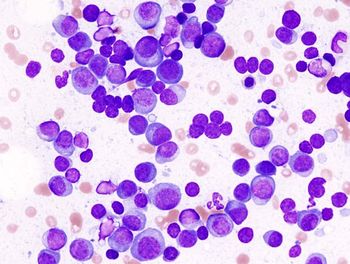
- Oncology Vol 30 No 4_Suppl_1
- Volume 30
- Issue 4_Suppl_1
(P032) Stereotactic Body Radiation Therapy for Bone Metastases From Prostate Cancer: Techniques and Outcomes From a Large Community Setting
SBRT is a very well-tolerated form of RT that appears to offer a statistically significant and high level of pain control for bone metastases from prostate cancer. In community practice, a highly variable fractionation scheme is also noted.
Ron Allison, MD, Sharon Salenius, MPH, Andrej Hnatov, MD, Cynthia Ballenger, MD, Anesa Ahamad, MD, Constantine Mantz, MD, Eduardo Fernandez, MD, Daniel Dosoretz, MD, Steven Finkelstein, MD; 21st Century Oncology
BACKGROUND: Bone metastases are a common and debilitating part of prostate cancer progression. Treatment options vary, but recently, stereotactic body radiation therapy (SBRT) has gained traction for this indication. We report response and morbidity in a cohort of men with bone metastases treated by radiosurgery in a community setting.
MATERIALS AND METHODS: We undertook an institutional review board–approved chart review of men with prostate cancer who underwent radiosurgery for bone metastases. A total of 121 men, mean age 73 years, received treatment to a total of 391 lesions. Most patients were progressing despite androgen deprivation therapy and/or chemotherapy. Bone scan, CT, and magnetic resonance imaging were commonly used for metastatic evaluation and/or treatment planning. The majority of patients (83%) were symptomatic due to bone pain at the time of SBRT. Radiosurgery was delivered by linear accelerator in 98% of patients vs 2% by CyberKnife. The mean number of lesions treated was 2.1 (range: 1–6). The spine was irradiated in 67% of patients, compared with irradiation of the ilium or sacrum in 14%, among various other bones. Fractionation was most commonly 8 Gy × 3 (34%), 5 Gy × 5 (19%), and 6 Gy × 5 (10%), followed by a variety of other schedules.
RESULTS: The mean follow-up time was 12 months (range: 0.1–80 mo). No acute morbidity was reported in 93% of patients, with grade 1/2 esophagitis seen in 4% as the most common acute side effect. There was one case of late morbidity (grade 1 lung fibrosis). The fractionation scheme did not appear to influence outcome or morbidity in this study. A statistically significant improvement in pain was seen (P = .0001), with nearly 95% reporting some level of improvement in pain.
CONCLUSIONS: SBRT is a very well-tolerated form of RT that appears to offer a statistically significant and high level of pain control for bone metastases from prostate cancer. In community practice, a highly variable fractionation scheme is also noted.
Proceedings of the 98th Annual Meeting of the American Radium Society -
Articles in this issue
Newsletter
Stay up to date on recent advances in the multidisciplinary approach to cancer.

















































































